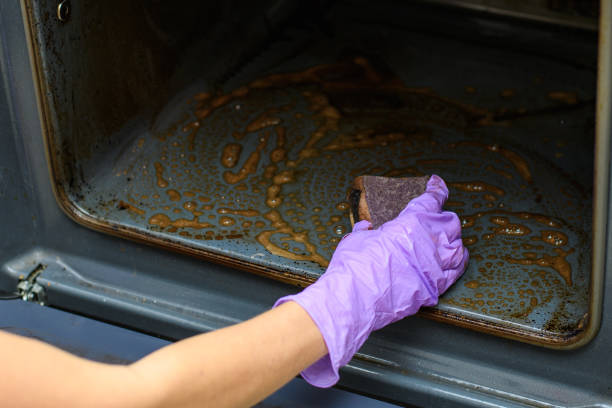Table of Contents
Toggle7 Mistakes to Avoid When Cleaning Your Kitchen Oven
Cleaning your kitchen oven is a task that many of us tend to overlook or procrastinate, often underestimating its importance beyond mere aesthetics. A clean oven isn’t just about a sparkling interior—it’s crucial for maintaining hygiene, ensuring efficiency in cooking, and extending the lifespan of your appliance. However, cleaning an oven isn’t without its pitfalls. Many people unknowingly make mistakes that can lead to damage or compromise the oven’s performance.
Why is it important to avoid common mistakes when cleaning your kitchen oven?
Proper oven maintenance is essential not only for appearance but also for hygiene, efficiency, and longevity of the appliance. By avoiding common cleaning mistakes, you can ensure your oven operates effectively, reduces the risk of damage, and maintains a safe cooking environment. This approach helps in avoiding unnecessary repairs or premature replacement, saving both time and money in the long run.
In this article, we’ll explore seven common mistakes to avoid when cleaning your kitchen oven in 2024. By steering clear of these errors, you can ensure your oven remains in top condition, providing you with reliable service for years to come.

Mistake 1: Using Harsh Chemical Cleaners
One of the most common mistakes people make when cleaning their oven is using harsh chemical cleaners. While it might seem like a quick solution to remove stubborn grease and grime, these chemicals can actually damage the interior of your oven, especially if it has a self-cleaning feature. The harsh ingredients can degrade surfaces, causing discoloration or even corrosion over time. Instead, opt for oven-specific cleaners or natural alternatives like baking soda and vinegar, which are effective yet gentle on your oven’s surfaces.

Mistake 2: Ignoring the Manufacturer’s Instructions
Every oven model is unique, and what works for one may not be suitable for another. Ignoring the manufacturer’s instructions for cleaning and maintenance can lead to unintended consequences. This includes using the wrong cleaning products or techniques that may void your warranty or cause damage. Always refer to the owner’s manual for guidance on the recommended cleaning methods and products specific to your oven model.

Mistake 3: Neglecting Regular Cleaning
Waiting too long between cleanings allows food residue, grease, and spills to accumulate inside your oven. This buildup not only becomes more challenging to clean over time but can also affect the flavor of your food and even create smoke or odors during cooking. Regular cleaning, ideally after every use or at least once a month, prevents excessive buildup and makes cleaning easier and more effective.

Mistake 4: Using Abrasive Cleaning Tools
Scrubbing your oven with abrasive tools like steel wool pads or harsh scrapers can scratch and damage its interior surfaces. This is especially true for ovens with non-stick coatings or delicate finishes. Instead, opt for non-abrasive sponges or soft cloths to gently remove grime without causing harm. For stubborn stains, allow baking soda paste or vinegar to sit on the affected areas before wiping clean with a soft cloth.

Mistake 5: Leaving Oven Racks Inside During Self-Cleaning Cycles
Many modern ovens feature a self-cleaning function designed to burn off food residue at very high temperatures. However, oven racks are typically not designed to withstand these extreme heat levels and can warp, discolor, or become permanently damaged. Always remove oven racks before initiating the self-clean cycle to avoid costly repairs or replacements.

Mistake 6: Cleaning the Oven While It’s Still Hot
Attempting to clean your oven immediately after use, when it’s still hot, poses several risks. Apart from the obvious danger of burns, cleaning a hot oven can cause cleaning products to evaporate too quickly, reducing their effectiveness. Wait until the oven has cooled to a safe temperature before starting the cleaning process to ensure thorough and safe results.

Mistake 7: Overlooking the Oven Door and Seals
The oven door and its seals are often overlooked during regular cleaning routines. However, these areas can accumulate grease, food residue, and spills that affect the oven’s efficiency and heat retention. Regularly clean the oven door inside and out, paying attention to the seals to ensure they remain intact and functional. Use a mild cleaner and soft cloth to remove buildup without damaging these sensitive components.

Conclusion
Cleaning your kitchen oven is more than just a chore—it’s a critical maintenance task that directly impacts its performance and longevity. By avoiding these seven common mistakes when cleaning your oven, you can ensure it operates efficiently, maintains optimal hygiene standards, and serves you well for years to come. Incorporate regular cleaning into your kitchen routine using appropriate methods and products, and your oven will reward you with consistent performance and reliability in your culinary endeavors.